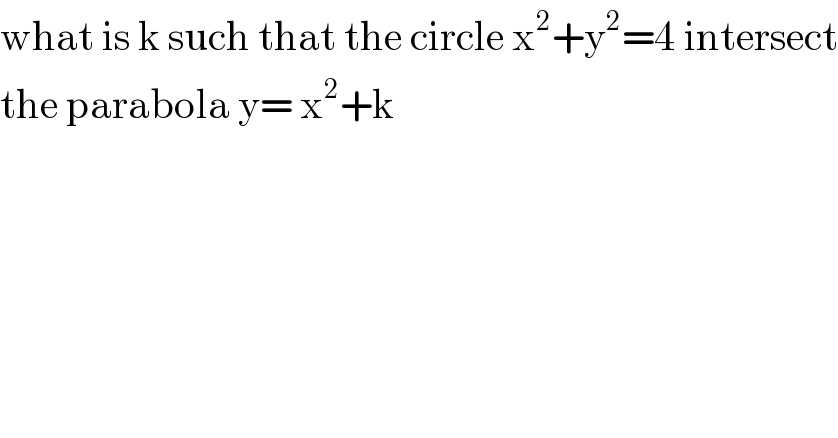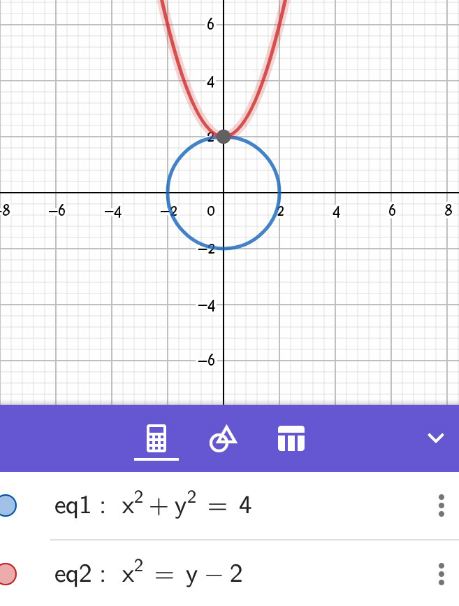
Previous in Relation and Functions Next in Relation and Functions
Question Number 106408 by bemath last updated on 05/Aug/20

$$\mathrm{what}\:\mathrm{is}\:\mathrm{k}\:\mathrm{such}\:\mathrm{that}\:\mathrm{the}\:\mathrm{circle}\:\mathrm{x}^{\mathrm{2}} +\mathrm{y}^{\mathrm{2}} =\mathrm{4}\:\mathrm{intersect} \\ $$$$\mathrm{the}\:\mathrm{parabola}\:\mathrm{y}=\:\mathrm{x}^{\mathrm{2}} +\mathrm{k}\: \\ $$
Answered by 1549442205PVT last updated on 06/Aug/20
![The circle intersection the parabol if and only if the system of equations { ((y=x^2 +k)),((x^2 +y^2 =4)) :} has the solution. Hence we need must to have : x^2 +(x^2 +k)^2 =4⇔x^4 +(2k+1)x^2 +k^2 −4=0(1) has the solution Set x^2 =t.(1)⇔t^2 +(2k+1)t+k^2 −4=0(2) The eqn.(1) has the solution if and only if the eqn.(2) has non−negative root which means equivalent to a)The case both roots are non−negative { ((Δ=(2k+1)^2 −4(k^2 −4)≥0)),((x_1 +x_2 =−(2k+1)≥0)),((x_1 x_2 =k^2 −4≥0)) :} ⇔ { ((4k+17≥0)),((k≤−(1/2))),((∣k∣≥2)) :}⇔ { ((k≥−((17)/4))),((k≤−(1/2))),((k∈(−∞;2]∪[2;+∞))) :} ⇔−((17)/4)≤k≤−(1/2) b)The case has only one root non−negative: { ((Δ=(2k+1)^2 −4(k^2 −4)≥0)),((x_1 x_2 =k^2 −4≤0)) :} ⇔ { ((4k+17≥0)),((∣k∣≤2)) :} ⇔ { ((k≥((−17)/4))),((−2≤k≤2)) :}⇔−2≤k≤2 Thus,The circle intersection the parabol if and only if k∈[−((17)/4);−(1/2)]∪[−2;2]](Q106411.png)
$$\mathrm{The}\:\mathrm{circle}\:\mathrm{intersection}\:\mathrm{the}\:\mathrm{parabol} \\ $$$$\mathrm{if}\:\mathrm{and}\:\mathrm{only}\:\mathrm{if}\:\mathrm{the}\:\mathrm{system}\:\mathrm{of}\:\mathrm{equations} \\ $$$$\begin{cases}{\mathrm{y}=\mathrm{x}^{\mathrm{2}} +\mathrm{k}}\\{\mathrm{x}^{\mathrm{2}} +\mathrm{y}^{\mathrm{2}} =\mathrm{4}}\end{cases}\:\mathrm{has}\:\mathrm{the}\:\mathrm{solution}. \\ $$$$\mathrm{Hence}\:\mathrm{we}\:\mathrm{need}\:\mathrm{must}\:\mathrm{to}\:\mathrm{have}\:: \\ $$$$\mathrm{x}^{\mathrm{2}} +\left(\mathrm{x}^{\mathrm{2}} +\mathrm{k}\right)^{\mathrm{2}} =\mathrm{4}\Leftrightarrow\mathrm{x}^{\mathrm{4}} +\left(\mathrm{2k}+\mathrm{1}\right)\mathrm{x}^{\mathrm{2}} +\mathrm{k}^{\mathrm{2}} −\mathrm{4}=\mathrm{0}\left(\mathrm{1}\right) \\ $$$$\mathrm{has}\:\mathrm{the}\:\mathrm{solution}\: \\ $$$$\mathrm{Set}\:\mathrm{x}^{\mathrm{2}} =\mathrm{t}.\left(\mathrm{1}\right)\Leftrightarrow\mathrm{t}^{\mathrm{2}} +\left(\mathrm{2k}+\mathrm{1}\right)\mathrm{t}+\mathrm{k}^{\mathrm{2}} −\mathrm{4}=\mathrm{0}\left(\mathrm{2}\right) \\ $$$$\mathrm{The}\:\mathrm{eqn}.\left(\mathrm{1}\right)\:\mathrm{has}\:\mathrm{the}\:\mathrm{solution}\:\mathrm{if}\:\mathrm{and}\:\mathrm{only} \\ $$$$\mathrm{if}\:\mathrm{the}\:\mathrm{eqn}.\left(\mathrm{2}\right)\:\mathrm{has}\:\mathrm{non}−\mathrm{negative}\:\mathrm{root} \\ $$$$\mathrm{which}\:\mathrm{means}\:\mathrm{equivalent}\:\mathrm{to} \\ $$$$\left.\mathrm{a}\right)\mathrm{The}\:\mathrm{case}\:\mathrm{both}\:\mathrm{roots}\:\mathrm{are}\:\mathrm{non}−\mathrm{negative} \\ $$$$\begin{cases}{\Delta=\left(\mathrm{2k}+\mathrm{1}\right)^{\mathrm{2}} −\mathrm{4}\left(\mathrm{k}^{\mathrm{2}} −\mathrm{4}\right)\geqslant\mathrm{0}}\\{\mathrm{x}_{\mathrm{1}} +\mathrm{x}_{\mathrm{2}} =−\left(\mathrm{2k}+\mathrm{1}\right)\geqslant\mathrm{0}}\\{\mathrm{x}_{\mathrm{1}} \mathrm{x}_{\mathrm{2}} =\mathrm{k}^{\mathrm{2}} −\mathrm{4}\geqslant\mathrm{0}}\end{cases}\:\: \\ $$$$\Leftrightarrow\begin{cases}{\mathrm{4k}+\mathrm{17}\geqslant\mathrm{0}}\\{\mathrm{k}\leqslant−\frac{\mathrm{1}}{\mathrm{2}}}\\{\mid\mathrm{k}\mid\geqslant\mathrm{2}}\end{cases}\Leftrightarrow\begin{cases}{\mathrm{k}\geqslant−\frac{\mathrm{17}}{\mathrm{4}}}\\{\mathrm{k}\leqslant−\frac{\mathrm{1}}{\mathrm{2}}}\\{\mathrm{k}\in\left(−\infty;\mathrm{2}\right]\cup\left[\mathrm{2};+\infty\right)}\end{cases} \\ $$$$\Leftrightarrow−\frac{\mathrm{17}}{\mathrm{4}}\leqslant\boldsymbol{\mathrm{k}}\leqslant−\frac{\mathrm{1}}{\mathrm{2}}\: \\ $$$$\left.\mathrm{b}\right)\mathrm{The}\:\mathrm{case}\:\mathrm{has}\:\mathrm{only}\:\mathrm{one}\:\mathrm{root}\:\mathrm{non}−\mathrm{negative}: \\ $$$$\begin{cases}{\Delta=\left(\mathrm{2k}+\mathrm{1}\right)^{\mathrm{2}} −\mathrm{4}\left(\mathrm{k}^{\mathrm{2}} −\mathrm{4}\right)\geqslant\mathrm{0}}\\{\mathrm{x}_{\mathrm{1}} \mathrm{x}_{\mathrm{2}} =\mathrm{k}^{\mathrm{2}} −\mathrm{4}\leqslant\mathrm{0}}\end{cases}\: \\ $$$$\Leftrightarrow\begin{cases}{\mathrm{4k}+\mathrm{17}\geqslant\mathrm{0}}\\{\mid\mathrm{k}\mid\leqslant\mathrm{2}}\end{cases}\:\Leftrightarrow\begin{cases}{\mathrm{k}\geqslant\frac{−\mathrm{17}}{\mathrm{4}}}\\{−\mathrm{2}\leqslant\mathrm{k}\leqslant\mathrm{2}}\end{cases}\Leftrightarrow−\mathrm{2}\leqslant\mathrm{k}\leqslant\mathrm{2} \\ $$$$\mathrm{Thus},\mathrm{The}\:\mathrm{circle}\:\mathrm{intersection}\:\mathrm{the}\:\:\mathrm{parabol} \\ $$$$\boldsymbol{\mathrm{if}}\:\boldsymbol{\mathrm{and}}\:\boldsymbol{\mathrm{only}}\:\boldsymbol{\mathrm{if}}\:\boldsymbol{\mathrm{k}}\in\left[−\frac{\mathrm{17}}{\mathrm{4}};−\frac{\mathrm{1}}{\mathrm{2}}\right]\cup\left[−\mathrm{2};\mathrm{2}\right] \\ $$
Commented by bemath last updated on 05/Aug/20

